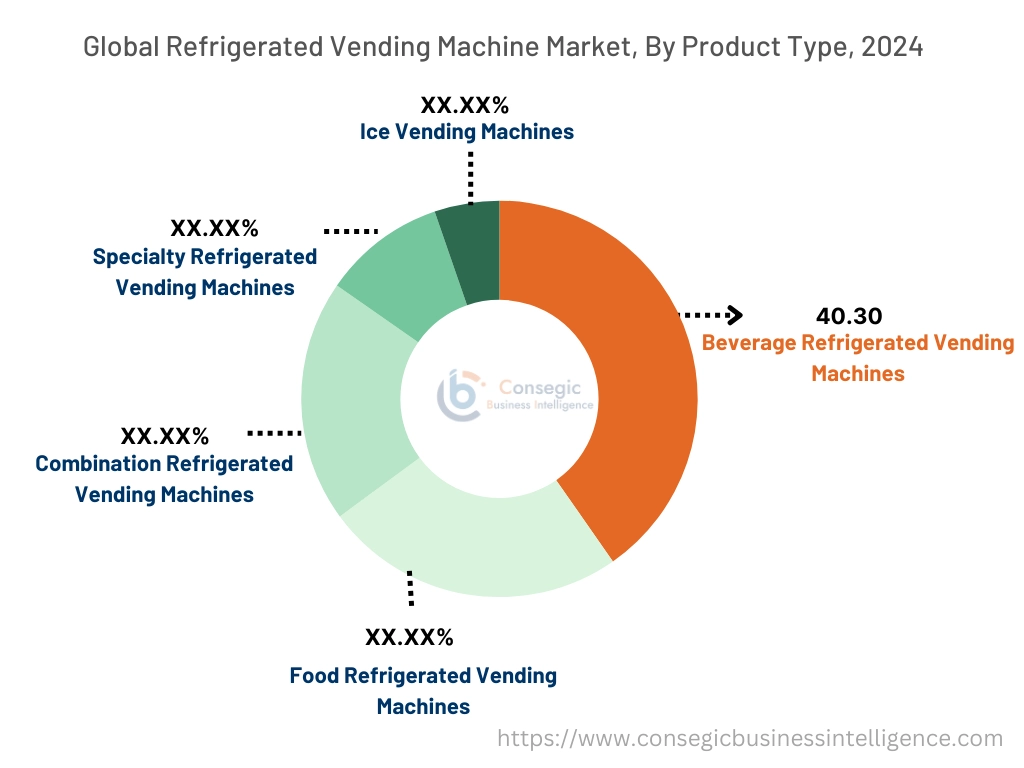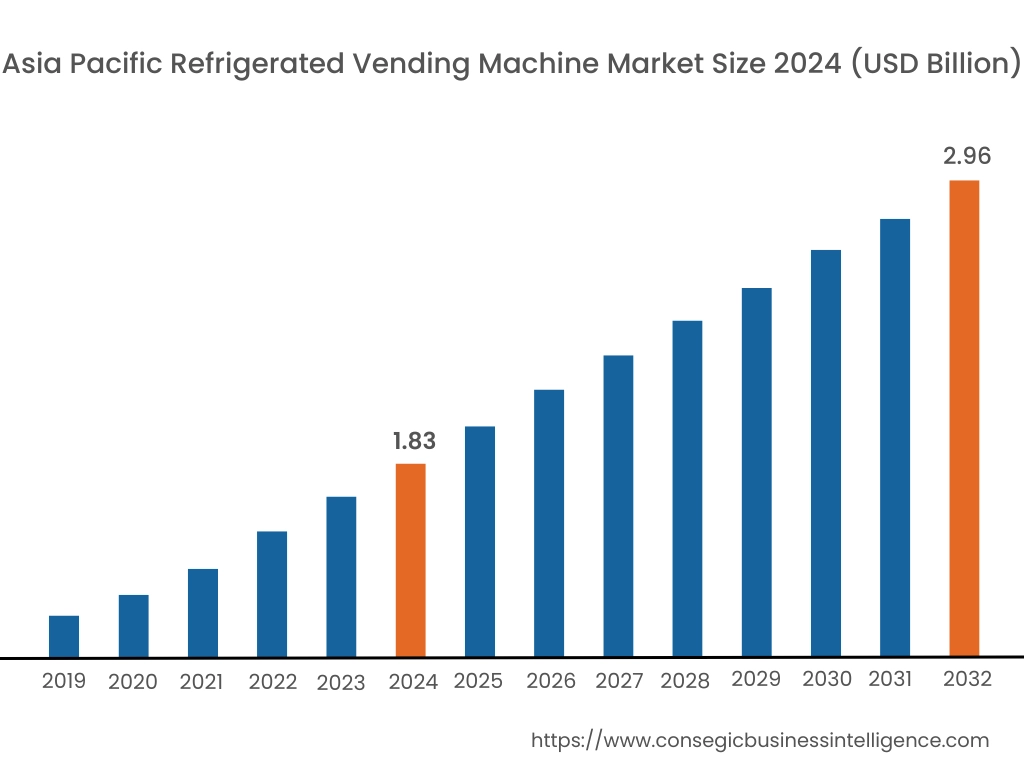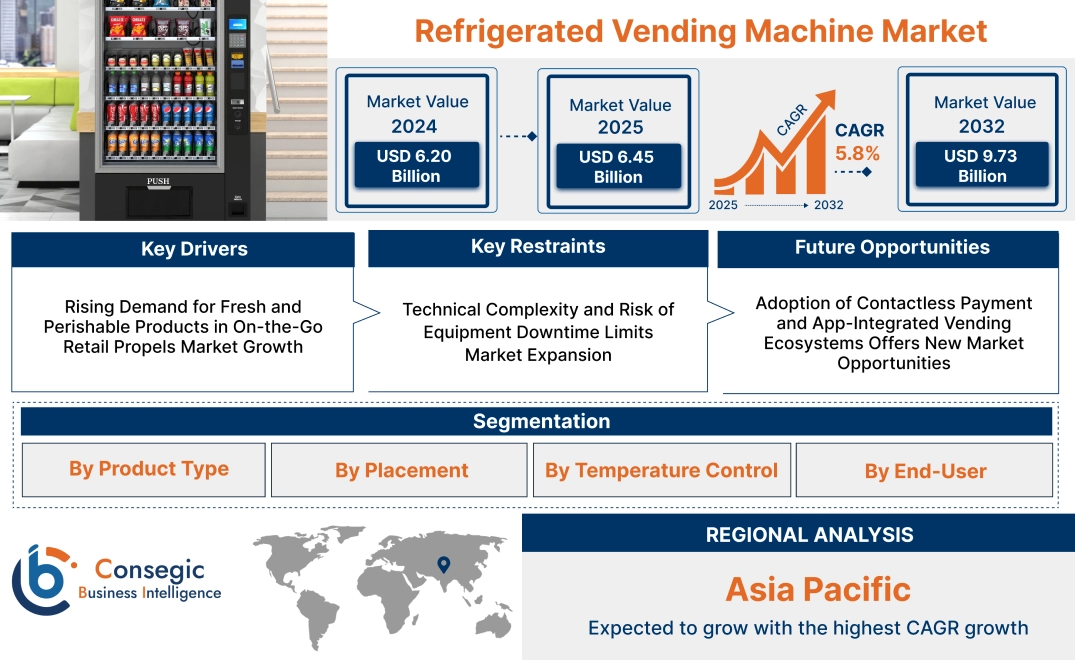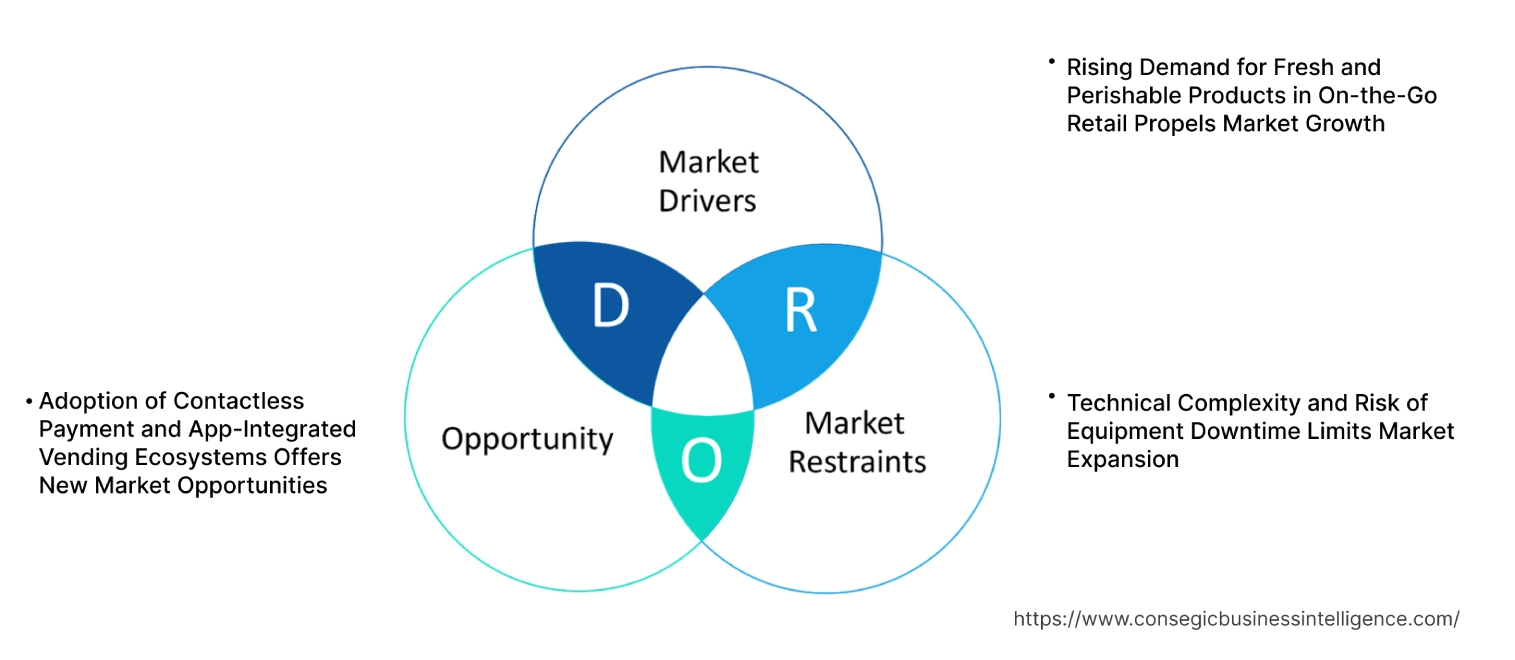- Summary
- Table Of Content
- Methodology
Refrigerated Vending Machine Market Size:
Refrigerated Vending Machine Market size is estimated to reach over USD 9.73 Billion by 2032 from a value of USD 6.20 Billion in 2024 and is projected to grow by USD 6.45 Billion in 2025, growing at a CAGR of 5.8% from 2025 to 2032.
Refrigerated Vending Machine Market Scope & Overview:
The refrigerated vending machine is a self-service retail unit equipped with integrated cooling technology designed to dispense perishable products while maintaining consistent temperature control. It is commonly used for storing beverages, dairy products, sandwiches, and other ready-to-eat items that require refrigeration to preserve freshness and safety.
Key features include automated temperature regulation, real-time inventory tracking, and user-friendly interfaces for quick transactions. Certain models also support contactless payment systems and programmable product displays, enhancing convenience and operational efficiency. Insulated interiors and energy-efficient components contribute to temperature stability and lower energy consumption.
Retail operators, transportation hubs, educational institutions, and workplaces utilize them to offer chilled food and beverage options in accessible locations. Their modular designs and mobility allow flexible placement, while digital connectivity enables remote monitoring and restocking optimization. These machines offer a reliable solution for delivering refrigerated goods with minimal staffing and round-the-clock availability.
Key Drivers:
Rising Demand for Fresh and Perishable Products in On-the-Go Retail Propels Market Growth
Urban consumers are increasingly seeking healthy, fresh food options that align with fast-paced lifestyles, fueling demand for on-the-go retail formats offering refrigerated meals, dairy, beverages, and produce. Traditional vending machines fall short in preserving product integrity, making refrigerated vending machines a critical addition to transit hubs, offices, educational campuses, and healthcare facilities. These systems allow for safe storage of perishable goods under controlled temperature environments, ensuring freshness and regulatory compliance. Retailers are using them to deliver extended foodservice without requiring labor-intensive operations. Their ability to offer a diverse range of temperature-sensitive items—such as salads, smoothies, and dairy-based snacks—while occupying minimal space has made them a preferred format for unattended retail. The expanding footprint of wellness-focused and convenience-driven food access points is directly contributing to the refrigerated vending machine market expansion.
Key Restraints:
Technical Complexity and Risk of Equipment Downtime Limits Market Expansion
Maintaining performance consistency in refrigerated vending machines involves precise refrigeration control, sensor integration, and software-hardware coordination. These machines rely on stable internal cooling, thermostatic precision, and proper air circulation to maintain food safety. Any deviation due to component failure, power disruption, or software malfunction increases the risk of spoilage, directly impacting operator revenues. Equipment downtime disrupts product availability and undermines user trust, especially in high-traffic locations. Moreover, the technical sophistication of these units demands specialized maintenance services, which are not readily available in every region. This limitation reduces operational scalability, particularly for smaller vendors or in underserved geographies. The need for constant monitoring, skilled servicing, and replacement parts creates logistical challenges and elevates the total cost of ownership. These performance and support complexities present a constraint on the refrigerated vending machine market growth.
Future Opportunities :
Adoption of Contactless Payment and App-Integrated Vending Ecosystems Offers New Market Opportunities
The integration of contactless payment systems and mobile applications is transforming refrigerated vending machines into intelligent, user-centric retail platforms. With consumers increasingly favoring tap-to-pay methods and digital wallets, these machines enable seamless transactions while minimizing physical interaction. App integration allows users to browse inventory, receive personalized offers, and access loyalty programs, enhancing user engagement and retention. Operators benefit from real-time sales data and inventory visibility, enabling dynamic restocking and targeted promotions. This digitization not only addresses rising demand for convenience and hygiene but also supports operational efficiency through centralized fleet management. Furthermore, software-enabled features open cross-selling and cross-category bundling strategies, making the machines more commercially productive. The convergence of digital interfaces with food retail is accelerating adoption across corporate campuses, public venues, and travel hubs.
- For instance, in February 2025, REDYREF launched a smart food vending fridge in collaboration with Royal Blue Grocery at AQUILA Commercial's Hartland City Club. The REDYREF Smart Food Fridge has RFID technology enabling fast, cashless transactions and smooth operations.
These innovations are unlocking long-term refrigerated vending machine market opportunities by aligning with evolving consumer preferences and retail automation trends.
Refrigerated Vending Machine Market Segmental Analysis :
By Product Type:
Based on product type, the refrigerated vending machine market is segmented into beverage refrigerated vending machines, food refrigerated vending machines, combination refrigerated vending machines, specialty refrigerated vending machines, and ice vending machines.
The beverage vending machines segment held the largest revenue share of 40.3% in 2024.
- These machines are widely deployed in high-footfall areas like offices, airports, and educational institutions to serve bottled and canned drinks.
- The need for chilled beverages is growing, driven by consumer convenience and round-the-clock availability.
- Market analysis shows beverage-focused units are preferred due to low maintenance and high refill cycles.
- As per the refrigerated vending machine market trends, the increased adoption of energy-efficient and contactless beverage vending models drives segment growth.
The specialty vending machines segment is projected to grow at the fastest CAGR during the forecast period.
- These machines cater to niche items such as flowers, dairy, fresh produce or cosmetics requiring precise refrigeration and display.
- The need for automated retail of fresh and sensitive products is expanding across developed economies.
- For instance, in November 2024, Unique Creations opened the first-ever flower vending machine in Newport Centre, Jersey City, U.S.A. This launch enabled customers to easily purchase flowers for their loved ones during the peak holiday season.
- Segmental trends highlight innovation in AI-powered vending platforms offering customization and real-time monitoring.
- This segment supports the refrigerated vending machine market expansion by enabling new use cases across retail and hospitality.

By Placement:
Based on placement, the market is segmented into wall-mounted, free-standing, and others (wheels or appliance casters).
The free-standing vending machines segment held the largest refrigerated vending machine market share in 2024.
- Their versatility and independence from fixed infrastructure make them suitable for indoor and outdoor placement.
- Their high visibility and accessibility in malls, airports, and transit stations enhance usage rates.
- Segmental analysis indicates operators prefer free-standing units for ease of relocation and restocking.
- Thus, with modular formats and plug-and-play deployment, this segment is central to the refrigerated vending machine market growth.
The wall-mounted machines segment is anticipated to experience the fastest CAGR during the forecast period.
- Wall-mounted units are ideal for space-constrained locations and smart building environments.
- The need for compact vending systems in coworking spaces, healthcare centers, and hotels is increasing.
- The refrigerated vending machine market demand is driven by new installation formats combining aesthetics, mobility, and real-time diagnostics.
- Therefore, this format aligns with urban space optimization, supporting targeted segment expansion.
By Temperature Control:
Based on temperature control, the market is segmented into single temperature zone, dual temperature zone, and multi-temperature zone.
The single temperature zone machines segment accounted for the largest revenue in 2024.
- These units are simpler to maintain and ideal for uniform product types such as bottled beverages or dairy items.
- They offer operators cost-efficiency and are widely used in public access areas.
- The refrigerated vending machine market analysis shows that their high volume deployment sustains supply chain consistency.
- Thus, continued requirement from institutional and commercial segments supports growth in this category.
The dual temperature zone machines segment is expected to witness the fastest CAGR during the forecast period.
- They offer flexible configuration for food and beverage combinations, allowing operators to diversify product offerings.
- The requirement for such hybrid snack-and-drink vending formats is increasing in entertainment venues and coworking hubs.
- The market demand is supported by trends in health snacks, protein drinks, and fresh food automation.
- Thus, this flexibility enhances unit economics, boosting segment-level contribution to refrigerated vending machine market trends.
By End-User:
Based on end-user, the refrigerated vending machine market is segmented into food & beverage operators, facility management companies, transportation & travel industry, institutions & government, hospitality & entertainment, and others.
The food & beverage operators segment held the dominant refrigerated vending machine market share in 2024.
- These businesses use vending machines to extend retail reach with minimal staffing and real estate costs.
- The need for 24/7 automated food delivery supports large-scale deployment across malls, campuses, and office parks.
- The refrigerated vending machine market analysis highlights the role of F&B brands in driving innovation in vending layouts, payment integration, and IoT systems.
- For instance, in December 2021, the Oyster HQ co-owner launched a vending machine specifically for oysters called Oyster Xpress at the beachfront in Australia. This decision allows consumers the convenience of purchasing seafood at any time.
- Ultimately, continued investment in smart vending ecosystems by global F&B players is a key growth driver.
The hospitality & entertainment segment is anticipated to witness the fastest CAGR during the forecast period.
- Hotels, cinemas, and event venues are increasingly adopting vending machines for self-service snacks and beverages.
- In fact, the need for efficient, contactless service channels has risen significantly post-pandemic. Customers expect higher quality as well as fast service, which is possible with vending machines.
- The refrigerated vending machine market demand in this segment is fueled by integration with loyalty apps and personalized marketing.
- Thus, with experience-focused venues seeking non-disruptive service enhancements, this sector supports market trends and long-term scalability.
Regional Analysis:
The regions covered are North America, Europe, Asia Pacific, the Middle East and Africa, and Latin America.

Asia Pacific region was valued at USD 1.83 Billion in 2024. Moreover, it is projected to grow by USD 1.90 Billion in 2025 and reach over USD 2.96 Billion by 2032. Out of this, China accounted for the maximum revenue share of 40.0%. Asia-Pacific is the fastest-growing region in the refrigerated vending machine industry, due to the rising urban density, tech-savvy population, and expanding demand for convenience-based retail. In countries such as China, Japan, South Korea, and India, vending machines have evolved into multi-functional retail hubs, offering fresh meals, dairy products, cold beverages, and even cosmetics. Regional growth is propelled by robust digital payment ecosystems and real-time data analytics that enable dynamic inventory management.
- For instance, in March 2020, Elanpro, a leading commercial refrigeration company, in collaboration with Vendekin, launched the first IoT-enabled refrigerators and vending machines in India. This aims to address the challenge associated with temperature management of tracking and monitoring changes in the various industries.
According to analysis, there is strong potential for further automation, including facial recognition and predictive stocking systems, presenting a substantial refrigerated vending machine market opportunity across both urban and semi-urban areas.

North America is estimated to reach over USD 3.15 Billion by 2032 from a value of USD 2.06 Billion in 2024 and is projected to grow by USD 2.13 Billion in 2025. North America holds a dominant share of the market, driven by a well-established vending culture and widespread adoption of contactless and smart retail technologies. In the United States and Canada, the market benefits from strong requirement for on-the-go fresh food, beverages, and healthy snack options. Additionally, integration with mobile payment systems and touchless interfaces enhances consumer convenience, making vending solutions appealing across universities, transportation hubs, and office spaces. Analysis suggests that ongoing investments in AI-powered inventory tracking and energy-efficient refrigeration are key to sustaining market momentum and addressing changing lifestyle preferences.
Europe represents a mature yet innovation-focused market where vending solutions are tightly integrated into urban infrastructure. Countries like Germany, France, Italy, and the UK are experiencing steady need, particularly in public transport zones, corporate settings, and educational institutions. There is also a rising emphasis on sustainability and energy compliance, leading to the deployment of eco-friendly machines with smart cooling systems. Regional analysis highlights that changing dietary habits and growing interest in fresh, locally sourced products are fostering demand for refrigerated vending systems tailored to premium and organic offerings. Additionally, the regulatory push by the EU towards reducing single-use plastics presents both challenges and incentives for format redesign.
Latin America is emerging as a promising market, especially in urban centers of Brazil, Mexico, and Argentina. The increasing presence of modern retail and convenience food services is contributing to moderate but growing interest in vending machines offering chilled beverages and fresh food. Market expansion is supported by improvements in payment infrastructure and a gradual shift in consumer preferences toward grab-and-go meal formats. Analysis suggests that partnerships between global vending operators and local distributors can unlock potential in high-footfall locations such as malls, airports, and commercial offices.
The Middle East and Africa have a nascent market that is gaining traction due to rising investments in hospitality, commercial infrastructure, and tourism. Countries in the Gulf region, particularly the UAE and Saudi Arabia, are adopting refrigerated vending units in airports, residential complexes, and public spaces. There is a growing preference for machines that provide cold bottled drinks, dairy items, and even ready-to-eat meals. Analysis indicates that climatic conditions necessitate robust cooling technologies, while future growth will depend on strengthening supply logistics and expanding access to digital payments.
Top Key Players and Market Share Insights:
The Refrigerated Vending Machine Market is highly competitive with major players providing products to the national and international markets. Key players are adopting several strategies in research and development (R&D), product innovation, and end-user launches to hold a strong position in the global Refrigerated Vending Machine Market. Key players in the smart robots industry include -
- Rheavendors Group (Italy)
- Azkoyen Group (Spain)
- Westomatic Vending Services Ltd. (United Kingdom)
- Fuji Electric Company Ltd. (Japan)
- Bianchi Vending Group (Italy)
- FAS International (Italy)
- Rockwell Industries Limited (India)
- Royal Vendors, Inc. (USA)
- SandenVendo America, Inc. (USA)
- Crane Merchandising Systems (USA)
Recent Industry Developments :
Partnerships:
- In July 2024, Copenhagen Airport partnered with iCoupon for 7-Eleven vending machines to provide travelers around-the-clock access to snacks and drinks. By providing passengers the option to redeem vouchers at the vending machines, this initiative enhances the customer experience.
Refrigerated Vending Machine Market Report Insights :
| Report Attributes | Report Details |
| Study Timeline | 2019-2032 |
| Market Size in 2032 | USD 9.73 Billion |
| CAGR (2025-2032) | 5.8% |
| By Product Type |
|
| By Placement |
|
| By Temperature Control |
|
| By End-User |
|
| By Region |
|
| Key Players |
|
| North America | U.S. Canada Mexico |
| Europe | U.K. Germany France Spain Italy Russia Benelux Rest of Europe |
| APAC | China South Korea Japan India Australia ASEAN Rest of Asia-Pacific |
| Middle East and Africa | GCC Turkey South Africa Rest of MEA |
| LATAM | Brazil Argentina Chile Rest of LATAM |
| Report Coverage |
|
Key Questions Answered in the Report
How big is the Refrigerated Vending Machine Market? +
Refrigerated Vending Machine Market size is estimated to reach over USD 9.73 Billion by 2032 from a value of USD 6.20 Billion in 2024 and is projected to grow by USD 6.45 Billion in 2025, growing at a CAGR of 5.8% from 2025 to 2032.
What specific segmentation details are covered in the Refrigerated Vending Machine Market report? +
The Refrigerated Vending Machine market report includes specific segmentation details for product type, placement, temperature control and end-user.
Which is the fastest-growing region in the Refrigerated Vending Machine Market? +
Asia Pacific is the fastest-growing region in the Refrigerated Vending Machine market. These trends are encouraged by the rising urban density, tech-savvy population, and expanding demand for convenience-based retail.
Who are the major players in the Refrigerated Vending Machine Market? +
The key participants in the Refrigerated Vending Machine market are Rheavendors Group (Italy), Azkoyen Group (Spain), Westomatic Vending Services Ltd. (United Kingdom), Fuji Electric Company Ltd. (Japan), Bianchi Vending Group (Italy), FAS International (Italy), Rockwell Industries Limited (India), Royal Vendors, Inc. (USA), SandenVendo America, Inc. (USA) and Crane Merchandising Systems (USA).


